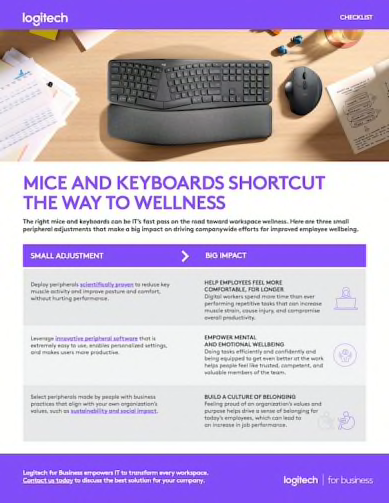WELLNESS CHECK:
The mind, body, mouse connection

Mental health in today’s workplace has become a major concern for employees.
of workers say poor mental health negatively impacted their work performance since the start of the pandemic“Global Employee Health Study,” Aetna International, 2020.
Employers should be concerned, too. The hit employee performance takes from mental health impacts can result in lost productivity. Since the pandemic began, more full-time workers in the U.S. lost 10-plus hours of productivity per week due to mental health.“2020 Behavioral Health Impact Update”, The Standard, 2020.
These short-term losses add up. And they can irreparably damage employee engagement, satisfaction, and overall wellbeing in the long run. Burnout was the top reason employees who started a new job in 2021 left their old one.“What’s Behind the Great Resignation? Blame Burnout”, HR Executive, 2021.
The right workspace experience to alleviate employee stress
Employee experience has become a weapon against such wellness-related challenges and talent retention woes. The better the employee experience, the better the business outcome. According to one report, every $1 USD a firm spends on employee experience resulted in $5 USD back “in increased employee productivity, organizational agility, and customer satisfaction.”“Invest in Employee Experience (EX), Drive Your Bottom Line Growth,” Forrester, 2020.
While IT leaders can’t support the mental health of workers directly, they can reduce the barriers to getting work done seamlessly and drive an improved employee experience at the same time.
The stress around tech issues, at least, can be alleviated by outfitting employees with hardware that works while charging, ensuring enterprise-grade wireless connectivity, and selecting software-empowered tools that streamline a workflow based on the end user’s personal preference.
By focusing on improving employees’ satisfaction with technology, many IT leaders have seen a significant improvement in their employee experience scores.“Invest in Employee Experience (EX), Drive Your Bottom Line Growth,” Forrester, 2020.
60%
of IT decision-makers said an employee’s satisfaction with technology had a positive impact on employee experience“Invest in Employee Experience (EX), Drive Your Bottom Line Growth,” Forrester, 2020.
Soft skill goals, hardware smarts
To support mental wellness within their organization, many business leaders have also turned to upskilling executives and employees in interpersonal areas. A McKinsey Global Survey found that some of the biggest jumps in reskilling focus from 2019 to 2020 fell into social and emotional categories. Companies addressing interpersonal and empathy skills nearly doubled year over year.“McKinsey Global Surveys 2021: A Year in Review,” 2021.
IT leaders expand these efforts into another dimension. Workspace technology can have a positive effect on employee wellbeing beyond physical comfort, particularly when it enables two outcomes:
End-user autonomy: The ability to do one’s tasks efficiently and confidently.
End-user mastery: The potential to get even better at one’s tasks.
Autonomy and mastery are overlooked essentials of employee wellbeing.“The overlooked essentials of employee well-being,” McKinsey & Company, 2018. These attributes of employee experience help people feel like trusted, competent, and valuable members of the team. Mice and keyboards that empower employees to achieve both are just one way IT can contribute to wider wellbeing efforts.

Belonging beyond socializing
When employees feel like they belong at work, they feel and do better at work. Creating a culture of belonging through organic face-to-face connections is a new challenge for distributed teams. But other avenues toward belonging exist.
Workplace belonging leads to a
increase in job performance
One example: Pride. “Feeling aligned to the organization’s purpose, mission, and values,” is one of the biggest drivers of employee belonging, according to Deloitte's 2020 Global Human Capital Trends survey.“The Social Enterprise at Work: Paradox as a Path Forward,” Deloitte Global Human Capital Trends Report, 2020.
The business benefits are inarguable. A whopping 93 percent of respondents in the same survey agreed that a sense of belonging drives organizational performance — one of the highest rates of consensus on importance Deloitte’s seen in a decade of findings.“The Social Enterprise at Work: Paradox as a Path Forward,” Deloitte Global Human Capital Trends Report, 2020.
of companies say a sense of employee belonging drives organizational performance“The Social Enterprise at Work: Paradox as a Path Forward,” Deloitte Global Human Capital Trends Report, 2020.
IT can leverage this data by outfitting remote workspaces with technology that fulfills the values their current workforce cares about, such as environmental responsibility, fair production practices, or inclusive and ergonomic design principles.
In this way,workspace technology choices can make off-site employees feel socially and emotionally engaged with their work community. Even when they can’t be together in person.
Physical and mental wellness are directly linked
Wellness in the workplace is often reactive, with improvements being driven through healthcare benefits after an injury or an incidence of burnout. It’s worth asking: Can a portion of a company’s wellness budget be taken to proactively equip employee workspaces against threats to employee wellbeing?
Workers with external wireless mice experience productivity benefits, but many IT organizations still don’t issue them with a laptop. A Logitech Ergo Lab study found that people are 50 percent more productive and 30 percent faster with a standard mouse compared to working a laptop touchpad.Logi Ergo Lab research, Logitech, Logitech standard mice compared to standard embedded trackpad, 2019.
of workers say their mental health was more important to them than the year before“Global Employee Health Study,” Aetna International, 2020.
Not only are these workers more productive, they’re more comfortable too. External mice and keyboards decrease muscle activity in the neck, shoulder, and forearm.
When comfort increases, both physical and mental wellbeing have a chance to improve, since the mind and body directly affect one another: Depressed patients have three times the average risk of developing chronic pain, according to Harvard Medical School research.“Hurting bodies and suffering minds often require the same treatment,” Harvard Medical School, 2017.
A seamless technology experience is a “stress less” one
Employee experience is the sum of all interactions a worker has with their company, so it’s important to recognize daily workspace interactions between employees and their tech. If a workspace is ill-equipped, there can be consequences for employees and employers alike.
Seemingly small IT decisions can actually be a great opportunity to say something to employees about the company’s values and support their physical and mental wellbeing at the same time.
The Logitech for Business lineup delivers a seamless technology experience in a hybrid world. All of our products work with leading enterprise operating systems and business apps, making global deployment seamless while keeping the power in IT’s hands.
MICE AND KEYBOARDS SHORTCUT THE WAY TO WELLNESS

Download the Checklist
SUBSCRIBE TO OUR BUSINESS NEWSLETTER
THANK YOU FOR CONTACTING US
A product expert will reach out to you shortly.